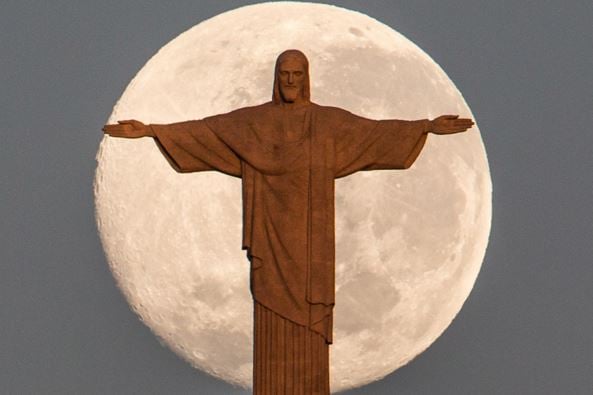This Christmas we have a full Moon, the first in thirty-eight years – since 1977. This rare event will not occur again until 2043. On Christmas Eve, Britons were able to see the International Space Station in the evening sky, shining like a bright star. Many parents with small kids probably mistook it for Santa on his sleigh.
Today’s full moon, the last of the year, is called a Full Cold Moon because it occurs during the beginning of winter. When the Full Cold Moon appears, winter has taken hold and temperatures have plummeted.
Sometimes the Full Cold Moon is called the Long Night Moon, because compared to the other seasons the nights are longer and the Moon spends longer above the horizon opposite a low Sun.
 According to NASA, this is how the moon will appear in the sky on Christmas Day. (Image: www.nasa.gov)
According to NASA, this is how the moon will appear in the sky on Christmas Day. (Image: www.nasa.gov)
Christian settlers often named it as the Moon Before Yule.
Warmest December on record
‘Cold’ is a relative term this year. In several parts of the UK and Europe, as well as the US East Coast, many people may be tempted to celebrate Christmas as if it were spring or autumn. According to the UK Met Office, December 2015 is set to be the warmest last month of the year in recorded history.
The Met Office made the following comment in its news blog:
“Mowing the lawn has been the reality for some so far this December, with unseasonably high temperatures. It looks as though the UK is on track to break the record for the warmest December since records began in 1910 and some areas have also seen their wettest.”
As you look at the sky today, NASA asks you to take note that its Lunar Reconnaissance Orbiter (LRO) is orbiting the Moon, as it has been since 2009.
John Keller, from NASA’s Goddard Space Flight Center in Greenbelt, Maryland, said:
“As we look at the moon on such an occasion, it’s worth remembering that the moon is more than just a celestial neighbor. The geologic history of the moon and Earth are intimately tied together such that the Earth would be a dramatically different planet without the moon.”
 A spectacular photograph of a full Moon behind the statue of Christ the Redeemer on the Corcovado mountain in Rio de Janeiro, Brazil.
A spectacular photograph of a full Moon behind the statue of Christ the Redeemer on the Corcovado mountain in Rio de Janeiro, Brazil.
Massive asteroid whizzes close to Earth today
A very large asteroid – called 163899 (2003 SD220) – whizzed quite closely past Earth on Christmas Eve. ‘Closely’ in astronomical terms, that is, which in this case was 6.8 million miles away. This may seem a long way away for us, but as far as astrophysicists and astronomers are concerned, that is nearly rubbing shoulders.
2003 SD220 is travelling at 7.3 metres per second or 16329.6 miles per hour, 28 lunar distances away, i.e. twenty-eight times the distance from Earth to the Moon.
Throughout the year, there have been several calamitous predictions online regarding this flyby. As occurs in every case, they were all wrong.
The Met Office has the following weather forecast for the UK on Christmas Day:
“On Christmas Day, northern and eastern parts will be brightest with a chilly, frosty start in the north and some wintry showers. Further south, it is likely to be cloudier with rain soon arriving in the southwest of England as a new low pressure system arrives from the Atlantic. This rain will then spread northeastwards through the day.”
“It will turn milder as the rain sets in, so we’re expecting a green Christmas rather than a white one for the majority of the UK.”
Video – First Christmas Full Moon since 1977

